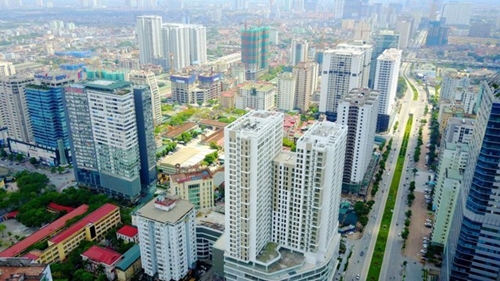Nguyen Van Dinh, VARS Vice President, told Vietnamplus that the reasons for that situation included strong reduction in new supply last year, a long Tet holiday and the novel coronavirus (COVID-19) pandemic.
“The number of transactions only accounted for about 10 percent of total offered property products in the first quarter, too low compared to the same period of last year,” Dinh said.
However, the price of apartments and low-rise houses in the quarter did not decrease against the fourth quarter of 2019. Now, there are no businesses announcing discounts for those products, he said.
    |
 |
|
Apartment buildings in Hanoi (Photo: tapchitaichinh.vn) |
According to the quarterly real estate market report released by VARS early this week, in the first quarter, property enterprises nationwide offered a total of 53,200 units in housing projects, while the successful housing transactions reached more than 7,600 units. The absorption rate of this housing segment was 14.3 percent.
Of which, the total new supply was nearly 18,700 housing units, including more than 8,350 apartments and more than 10,300 low-rise houses. The successful transactions for the new supply reached more than 2,750 housing units.
Meanwhile, the inventory was more than 34,550 products, including 4,872 products traded successfully.
The luxury apartment segment had the largest inventory, the association said.
According to the Hanoi Department of Construction, about 8,900 apartments were offered in the Hanoi market in the first quarter, including 1,167 newly-launched products. The market had only 1,300 successful apartment transactions.
The Ho Chi Minh City Department of Construction said more than 8,400 apartments were offered on the city market in the first quarter, including 4,664 newly-launched products. The market had 1,400 successful apartment transactions.
VARS reported that in the property market in other localities, transactions were mainly landed property. Before the Lunar New Year festival, these products still attracted many customers and small investors but now, due to the pandemic, the transactions of those products was very quiet.
Besides that, the pandemic made large investors and trading floors suspend trading activities of their products because customers do not want to come to crowded places. About 50 percent of total real estate trading floors must close and many property brokers are unemployed.
For the resort segment, the market had few newly-launched products while some products of the inventory were traded successfully in the first quarter.
The association also reported in this quarter, there was a virtual land fever in Thach That district, Hanoi, and Ba Ria - Vung Tau province.
Dinh said in the second quarter this year, the domestic property market would remain stagnant like in the first quarter, especially the resort segment.
The Hanoi and HCM City markets are expected to have traded apartments in the second quarter but the volume would be low and mainly in the affordable and mid-grade segments due to high demand, he said.
Those two large markets are predicted to have not many newly-launched apartments so property products that are traded on the markets would mainly be inventory goods.
VARS also forecasts that the land and landed property will remain the dominant product in many provinces and cities, excluding Hanoi and HCM City. However, transactions are likely to decline sharply over the same period of last year.
Prices of affordable and mid-end apartments in urban areas are expected to not increase because of low demand during the pandemic and high inventory, according to the association.
Meanwhile, price of high-end apartments may fall because capital pressure would force investors to reduce the price.
Source: VNA